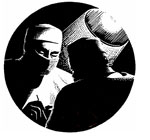
The Physicians’ Crusade Against Abortion
THE LAWS HAVE ENDED, BUT THEIR LEGACY LINGERS ON
What is the legacy of the laws overturned by Roe v. Wade? You probably can see some of it when you look in a mirror. If through late immigration, early Catholic ancestry, or sheer coincidence you do not owe your own existence to these laws, you can still be sure that most people you know or know of in the U.S. would not be alive today had it not been for these laws. The laws were passed from 1860 to 1880 to counter an epidemic of induced abortions among married Protestant women. Physicians were largely responsible for their passage. However, abortion legislation was only one goal of the “physicians’ crusade against abortion,” as it was termed by historian James C. Mohr. The other was to convince women to continue unwanted pregnancies. The physicians were highly successful in enacting stringent anti-abortion laws. They were not as successful in preventing abortions, but most Americans can be immensely thankful for their successes.
Almost everyone agrees that abortions increased in the U.S. after Roe v. Wade overturned the state laws against abortion. The best evidence for this is the sharp rise in legal abortions during the initial years following that decision. According to the Guttmacher Institute, abortions gradually rose from 898,600 in 1974, the full year following legalization, to 1,497,700 in 1979. After 1979, the number stabilized for several years at around 1,570,000. The gradual increase from 1974 through 1979 suggests that the overturned laws continued to have an effect for six years after their nullification. This could have occurred because women still felt that abortions were illegal or because physicians continued their prior habit of persuading women to continue unwanted pregnancies. As will be shown, it was largely such physician persuasion that reduced the rate of abortion from 1860 when the first of the stringent anti-abortion laws was passed until (at least) 1973 when all of the state laws were overturned.
It was primarily married Protestant women who sought abortions, who obtained abortions, and who were talked out of having abortions in the 19th century. Catholic married women did not seek abortions in any numbers until a decade or two into the 20th. Horatio Robinson Storer, the acknowledged leader of the physicians’ crusade against abortion, explained Catholics’ early abstinence from abortion in the third of a series of nine articles on abortion published in 1859 in the North-American Medico-Chirurgical Review. He wrote: “There can be no doubt that the Romish ordinance, flanked on the one hand by the confessional, and by denouncement and excommunication on the other, has saved to the world thousands of infant lives.” As will be seen, other physicians would note the success of the Catholic confessional in keeping women from abortion and also the similarities between that confessional and the physician’s private office.
You May Also Enjoy
The U.S. bishops did not intend to suggest that Catholics who vote for a pro-choice candidates are putting their souls in jeopardy.
Given there is no explicit condemnation of abortion in the Bible, how can the sola Scriptura premise of fundamentalist Protestants yield a strong pro-life stance?
During in utero fetal surgery, the unborn infant stretched out its little hand and clutched the finger of the surgeon.

